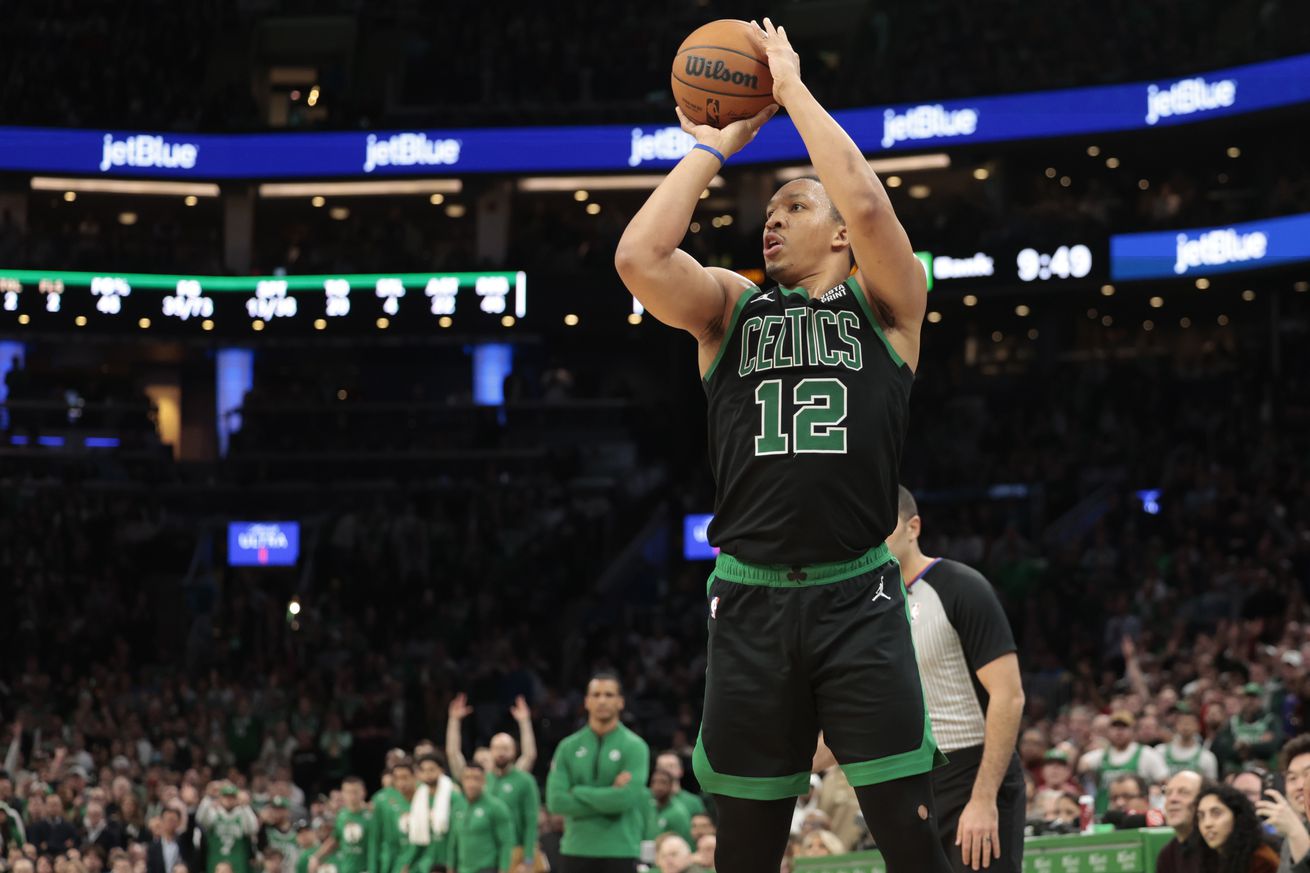
Photo by Nick Grace/Getty Images
The fourth-year forward is thriving in the league’s top-ranked offense.
At this stage, most know the story. As a rookie, Grant Williams misfired on his first 25 3-point attempts. The calendar reached the second week of December before one fell through the net. His Boston Celtics teammates sarcastically nicknamed him Ben Simmons to parallel their frigid jumpers. Williams ended 2019-20 drilling 25 percent of his looks beyond the arc. His true shooting percentage was a paltry 50.5.
A season later, he continued progressing and converted 37.2 percent of his long balls. Yet he couldn’t figure out how to score inside the arc, sporting a 50.8 percent clip (2.2 points below league average) and registering a 54.6 true shooting percentage. The past two seasons, Williams has merged exterior and interior prowess.
He’s buried 42.4 percent of his threes, including 46.5 percent this year. His jumper invokes fear in defenses, which springs free room to explore downhill. He’s shooting 69.2 percent inside the arc, up from 56.9 percent in 2021-22 and 52.8 percent across his first two seasons. His 71.7 true shooting percentage leads the NBA.
While some may have wondered or worried whether Williams’ long-range marksmanship was a fluke, he’s decided to empathically convey the opposite. His release is quicker in the face of punctual closeouts. He’s added the nifty and practical sidestep triple to his arsenal. He’s attempting more off-the-dribble ventures — his pull-up three frequency has spiked from 4.2 percent last year to 13.3 percent (12 of 22 thus far).
The footwork that helped propel him to stardom as the two-time SEC Player of the Year at the University of Tennessee accentuates his budding jumper. The 6-foot-6 wing is by no means confined to stationary spot-ups. There’s genuine diversity in how he’s generating volume from deep. Last season wasn’t a fluke, it was a launching pad.
Between the 2021-22 regular season and playoffs, Williams hoisted 347 threes and made 40.6 percent of them. Considering he ranks 10th in usage rate on the league’s most efficient offense, opponents still prioritize other options before limiting his volume. But he’s a legitimate threat and more routinely viewed as such than prior years. This evolving dynamic has enabled Williams to expand his repertoire when exiled off the three-point line.
He’s also garnering a bit of newfound autonomy to showcase these strides; compared to last year, his time of possession and average dribbles per touch have perked up. After producing points on just 53.7 percent of his drives a season ago, he’s doing so on 74.6 percent of his drives this season.
He’s zippier off the bounce, looks more comfortable navigating tight windows and seems to holster improved flexibility. According to Cleaning The Glass, his rate of assisted makes has declined from 86 percent to 79 percent. Inklings of the creation chops evident in college are surfacing.
The dribble-pass-shoot ethos of the Celtics’ offense has made its way to Williams’ portfolio. He’s shooting 79 percent at the rim (87th percentile among bigs) and 59 percent from short midrange (88th percentile). Intermediate touch was a hallmark of his pre-draft allure and he’s actualizing it in Year Four.
Defenses can’t successfully stash their weakest link on him. Whether it’s with the jumper or as a driver, he’ll exploit it. He’s also willing to flow into an action with one of Boston’s various ball-handlers, become a screener and let somebody else exploit the mismatch presented to him.
The Celtics’ offense flourishes in part because of off-ball screens, be it flares, pindowns or veers. Williams is a tremendous screener who recognizes when to hold for contact or slip inside early because the defense is overplaying against shooters. He’s comfortable drifting out of screens for threes and is a snappy passer whose decision-making helps amplify advantages. His mastery of the sly, cheeky Gortat Seal is growing and simplifying driving lanes for teammates.
The first two years of Williams’ career portrayed a very good defender whose undersized frame and offensive rigidity complicated how much he could play to augment that defensive talent. He remains a high-level defender, equipped to thrive in Boston’s switch-heavy scheme and deploys his dexterity to disrupt opponents’ rhythm.
This year, he’s anything but a rigid offensive cog and leverages his ridiculous strength to mitigate the hurdles of his frame and limited vertical pop. In last season’s playoffs, he shot a meager 49.2 percent on two-pointers. His intermediate touch escaped him. In the Finals, the Celtics’ offense crumbled; they couldn’t score inside the arc or protect the ball.
Both will be aiming to avoid these pitfalls come springtime. Williams’ development and further emergence may help them accomplish those objectives together.

Must See
-


American Football
/ 4 hours agoRory McIlroy, despite alleged Tiger Woods fallout, to negotiate with Saudi PIF
Rory McIlroy during the first round of the 2024 Wells Fargo Championship. | Photo...
By -


American Football
/ 4 hours agoWells Fargo: Collin Morikawa attacks “big boy” course to sit near the top
Photo by Ben Jared/PGA TOUR via Getty Images Morikawa battled Quail Hollow at the...
By -


American Football
/ 5 hours agoRose Zhang does best Nelly Korda impression, dominates Cognizant Founders Cup
Photo by Harry How/Getty Images Zhang was locked in at the Cognizant Founders Cup...
By





